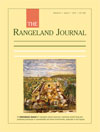RJ11073Transitions across thresholds of vegetation states in the grazed rangelands of Western Australia
Rangelands can be found in multiple vegetation states, with transitions representing the paths between each state. A rangeland monitoring dataset from Western Australia was examined to identify contemporary transitions. The number of transitions was low and was more frequent in grassland than shrubland systems.




